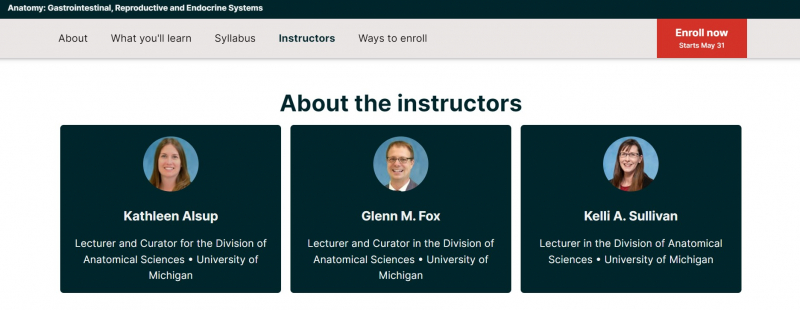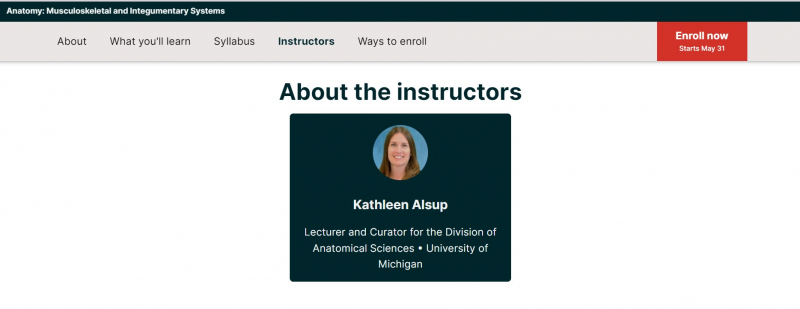Top 10 Best Online Anatomy Courses
You most likely have a basic understanding of how your body functions. But do you fully comprehend how the human body's complex functions and systems work ... read more...together to keep you healthy? That is why you should enroll in an anatomy course! This is the list of the best online Anatomy courses that Toplist has compiled for you!
-
"Anatomy Specialization" from Coursera will be the first name on the list of the best online Anatomy courses that Toplist has compiled for you. This specialization will help you understand the characteristics of various organ systems and the shape and function of the human body by using a systems approach and an extensive library of multimedia materials. To help you better understand the subjects, this specialization uses a highly visual multimedia library of accurate anatomical models and materials. Besides, you learn about the different types of joints, their functions, and clinical correlations, and about the anatomy and function of skeletal muscles. The organ systems covered by this specialization include the integumentary system, cardiovascular system, musculoskeletal system, urinary system, nerves, respiratory system, reproductive system, gastrointestinal system, and endocrine system.
You will receive a certificate when you finish each course and the hands-on project, which you can share with potential employers and your professional network.
This course offers:
- Shareable Certificate
- 100% online courses
- Flexible Schedule
- Beginner Level
- Subtitles: English, Arabic, Russian, German, French, Portuguese (European), Italian, Catalan, Vietnamese, Spanish
Course by: Coursera
Coursera Rating: 4.8/5.0
Enroll here: coursera.org/specializations/anatomy
Photo: coursera.com 
Photo: coursera.com -
The next name on the list is "Essential Human Biology: Cells and Tissues" from edX. This course will provide you with a solid foundation of human anatomy and physiology knowledge. In both health and disease, you will gain a broad understanding of the relationships between normal structure and function in human cells and tissues. The properties of the body's four major types of tissue - epithelial, connective, muscular, and nervous - will also be thoroughly explained.
To guide you through key concepts and make learning relevant, the course uses a variety of engaging learning methods, such as short videos, animations, interactive activities, and integrated quizzes. After taking part in this course, you can learn about the basic knowledge of human anatomy and physiology, the preparation for a career in health care and the study of health sciences, and the ability to understand the structure and function of human cells and tissues.
This course offers:
- Introductory Level
- Language: English
- Video Transcript: English
- Prerequisites: There are no formal prerequisites, but a basic understanding of biology may be beneficial.
Course by: edX
Enroll here: edx.org/course/essential-human-biology-cells-and-tissues

Photo: edx.org 
Photo: edx.org -
"Anatomy: Cardiovascular, Urinary, and Respiratory Systems" is the next name on the list of the best online Anatomy courses that Toplist would like to introduce to you. The interactive relationships of the cardiovascular, respiratory, and urinary systems, as well as the roles they play in your body, will be explored in this anatomy course, which is part of the Anatomy XSeries. After finishing this course, you will gain knowledge about the basic structure and function of the cardiovascular system, the respiratory system, and the urinary system.
In this anatomy course, students will have the chance to learn the pertinent details of the structures and functions of the cardiovascular, respiratory, and urinary systems through a combination of lectures, videos, labeling activities, and quizzes in this course. Another thing you should know about this course is that it is at the introductory level. Besides, the language of this course and the video transcript is English.
This course offers:
- Introductory Level
- Prerequisites: Basic biology
- Language: English
- Video Transcript: English
- Associated programs: XSeries in Anatomy
Course by: edX
Enroll here: edx.org/course/anatomy-cardiovascular-urinary-and-respiratory-sys
Photo: edx.org 
Photo: edx.org -
"Anatomy: Gastrointestinal, Reproductive and Endocrine Systems" is the next name on the list that Toplist would like to share with you. The syllabus of this course has three main parts, including Gastrointestinal System, Endocrine System, and Reproductive Anatomy & Functions. You will learn about the various digestive, endocrine, and reproductive organs, their functions, and the nerves and blood vessels that serve these organs in this Anatomy XSeries course. To emphasize the importance of these anatomical structures and their relationships, clinical correlations and vignettes will be used. In addition to that, to illustrate these concepts, images, and videos from cadaveric and artistic materials will be used in this course.
After finishing this course, you will understand the gastrointestinal, endocrine, and reproductive systems' basic anatomy as well as important clinical concepts, and learn about the gastrointestinal, reproductive, and endocrine systems' primary functions on their own and in relation to the human body.
This course offers:
- Level: Introductory
- Prerequisites: Basic biology
- Language: English
- Video Transcript: English
- Associated programs: XSeries in Anatomy
Course by: edX
Enroll here: edx.org/course/anatomy-gastrointestinal-reproductive-and-endocrin
Photo: edx.org 
Photo: edx.org -
The next name on the list of the best online Anatomy courses is "Anatomy: Musculoskeletal and Integumentary Systems" from edX. In this Anatomy XSeries course, you will have a chance to learn how the integumentary system (epidermis, dermis, hair, nails, and glands) protects and allows the body to move, as well as how the musculoskeletal system (bones, joints, and skeletal muscles) protects and allows the body to move. In addition, you will learn about these properties and functions through fascinating videos, lectures, and anatomical visual materials (illustrations and cadaveric images). Three main parts in the syllabus of this course are Integumentary Systems, Skeletal Muscle Anatomy, and Joints.
After taking part in this course, you will be able to understand the anatomy and function of the integumentary system, understand the anatomy and function of the skeletal system, know more about the different types of joints, their functions, and clinical correlations, and learn about the anatomy and function of skeletal muscles.
This course offers:
- Level: Introductory
- Prerequisites: Basic biology
- Language: English
- Video Transcript: English
- Associated programs: XSeries in Anatomy
Course by: edX
Enroll here: edx.org/course/anatomy-musculoskeletal-and-integumentary-systems

Photo: edx.org 
Photo: edx.org -
"Vital Signs: Understanding What the Body Is Telling Us" is the next name on the list. The vital signs – heart rate, blood pressure, body temperature, respiration rate, and pain – convey vital information about the human body's physiological status. This course will look at the anatomy and physiology that underpins vital signs in this six-part course so that you can develop a systematic, integrated understanding of how the body works.
The cardiovascular and respiratory systems are discussed, followed by explanations of how the function of these systems affects vital signs. This course will talk about normal ranges, normal variants, and the mechanisms that underpin changes in objective vital sign measurements. Demonstrations of appropriate techniques for measuring vital signs in yourself and others are also included in the course. Those working in healthcare, those with an interest in personal health and fitness, those considering a career as a healthcare professional, lay caregivers, or anyone who simply wants to understand how the body functions will find the course particularly interesting.
This course offers:
- Flexible deadlines
- Shareable Certificate
- 100% online
- Subtitles: Arabic, Catalan, French, Czech, Portuguese (European), Italian, Vietnamese, Dutch, Korean, German, Russian, English, Spanish
Course by: Coursera
Coursera Rating: 4.8/5.0
Enroll here: coursera.org/learn/vital-signs

Photo: coursera.org 
Photo: coursera.org -
In this anatomy course, "Anatomy of the Abdomen and Pelvis; a journey from basis to clinic", you'll learn about the organs that help us digest food and the most common causes of abdominal and pelvic pain. The most up-to-date graphics and animations will assist you in gaining new insights and understanding of this body part, which has been the subject of anatomical research for centuries and is currently generating renewed scientific interest.
You will learn everything there is to know about 3D organ anatomy, from the fundamentals of anatomical understanding to advanced surgical procedures. This course will challenge you to discover and understand the anatomy of the abdomen and pelvis in all of its aspects, from its embryological underpinnings to gross topography and clinical applications, through digital microscopy. The course is unique in that it connects basic anatomical knowledge from the lab with medical applications and current diagnostic techniques on a continuous basis. In forum discussions, you will have the opportunity to discuss anatomical and clinical issues with peers and experts, and you will be guided in exploring the wealth of anatomical information accumulated over the centuries.
This course offers:
- Flexible deadlines
- Shareable Certificate
- 100% online
- Subtitles: English, French, Catalan, Portuguese (European), Russian, Spanish
Course by: Coursera
Coursera Rating: 4.7/5.0
Enroll here: coursera.org/learn/abdomen-anatomy
Photo: coursera.org 
Photo: coursera.org -
"Applied anatomy of the locomotor system" is the eighth name on the list. This course is intended to act as a bridge between descriptive anatomy and clinical anatomy skills. The course is divided into two sections: first, a detailed description of bones, joints, and muscles at the cellular and tissue levels of the organization; and second, a regional discussion of the human skeletal, articular, and muscular systems in various body parts. Each lesson includes integrated basic, functional, and radiological anatomy materials, as well as links to verified learning resources that contain real-world examples of anatomical knowledge.
The course structure is designed to alleviate the memory strain commonly associated with anatomy studies, as it is much easier to remember relevant facts if they have a clear and immediate meaning. In fact, undergraduate students studying medicine, physical therapy, physical education, and sports science will benefit from the coursework. Furthermore, postgraduate interns in orthopedics, sports medicine, or rehabilitation may find the content informative and interesting, and use it to either deepen or refresh their knowledge.
This course offers:
- Level: Intermediate
- Prerequisites: None
- Language: English
- Video Transcript: English
Course by: edX
Enroll here: edx.org/course/applied-anatomy-of-the-locomotor-system
Photo: edx.org 
Photo: edx.org -
"Cell Biology: Mitochondria" from edX will be the next name on the list of the best online Anatomy courses that Toplist would like to share with you. The cell is an excellent model for studying the functional logic of living systems. The function of the molecular components of cells, as well as how these cellular components are organized into a complex hierarchy, will be explored in this course to learn the how and why of biology.
The goal of this course is to cover the fundamentals of cell biology. The overarching goal is for students to understand that cells evolve ensembles of macromolecules that form complex communities in tissues, organs, and multicellular organisms from a human-centered perspective. This course will concentrate on the mitochondrion, which is the cell's powerhouse organelle. Besides, this course looks at the processes of cell metabolism in this context. Finally, let’s look at the F1F0 ATP synthase, the molecular machine that produces the majority of the ATP that your cells need to function.
This course offers:
- Level: Introductory
- Prerequisites: None
- Language: English
- Video Transcript: English
Course by: edX
Enroll here: edx.org/course/cell-biology-mitochondria

Photo: edx.org 
Photo: edx.org -
What is the structure of the human body? What is the relationship between the various body systems? This course, "Human Anatomy for Stroke", is for you if you are interested in Human Anatomy but are a layperson, if you find human anatomy textbooks too difficult to read, or if you want to refresh your anatomy knowledge quickly.
Any medical or healthcare professional must have a basic understanding of human anatomy. Anatomy and stroke effects, on the other hand, are extremely useful for anyone interested in learning more about the human body. In this course, you will learn the fundamentals of anatomy and how to "dissect" the human body using a logical approach while working through a typical clinical case of stroke. Besides, anatomy knowledge that is relevant to the application of clinical procedures and anatomy of relevant body systems at gross and histological levels will be introduced to you in this course.
This course offers:
- Level: Introductory
- Prerequisites: None
- Language: English
- Video Transcript: English
- Associated programs: Professional Certificate in Introduction to Stroke Care
Course by: edX
Enroll here: edx.org/course/human-anatomy
Photo: edx.org 
Photo: edx.org































